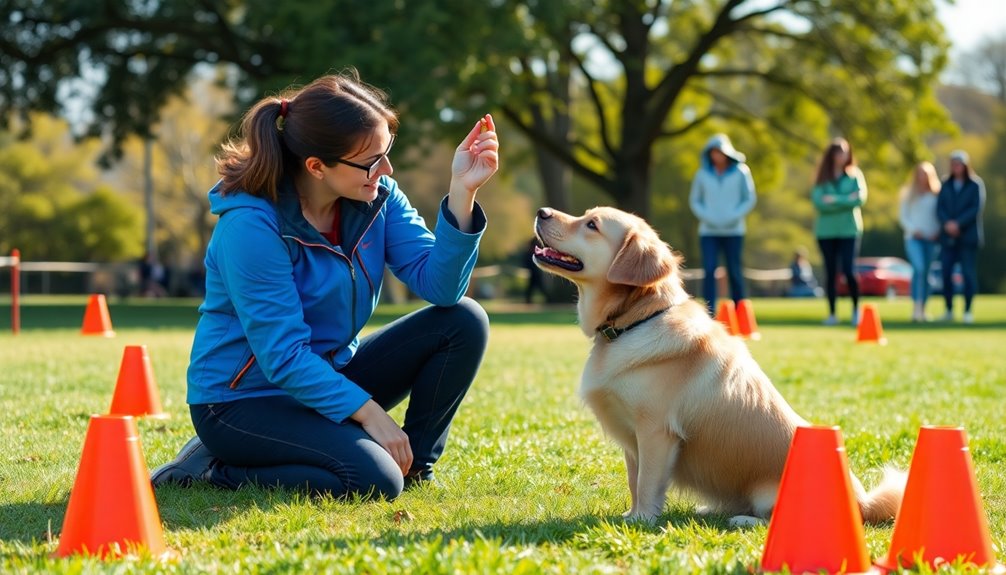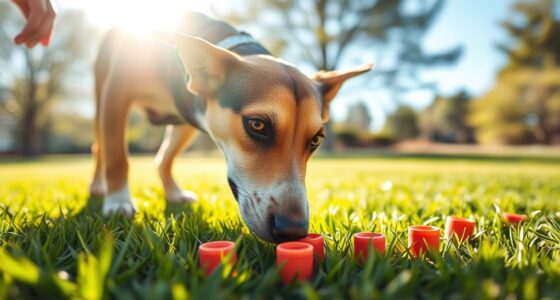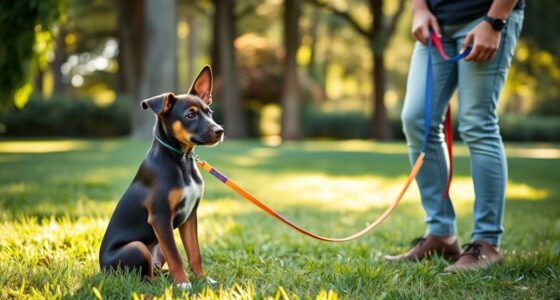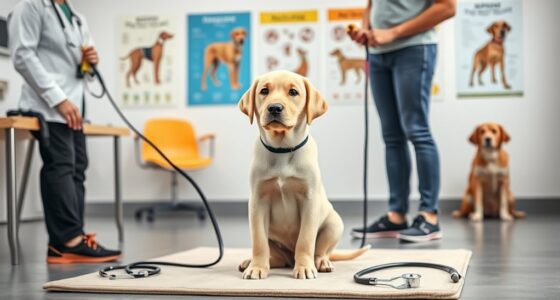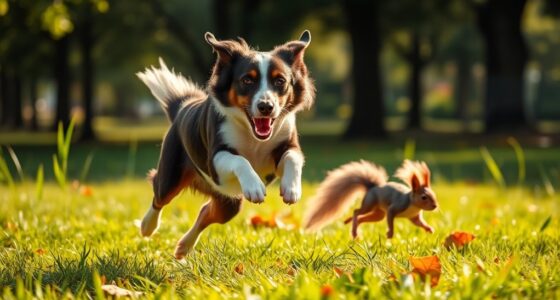To train your dog like a pro, focus on mental stimulation and regular exercise. Use puzzle toys and engage in interactive games to keep their minds sharp. Mix up your walks by changing routes or hiding treats for them to find. Positive reinforcement is essential—reward good behavior immediately with treats or praise. Incorporate fun activities like trick training or hide-and-seek to strengthen your bond. Also, tailor your training to your dog's age and maintain a healthy diet. By applying these techniques, you'll reveal even more effective strategies that can transform your dog's training journey.
Key Takeaways
- Utilize positive reinforcement techniques, like treats and praise, to encourage desired behaviors and strengthen your bond with your dog.
- Incorporate clicker training for immediate feedback, enhancing your dog's understanding of commands and improving behavior retention.
- Engage in regular training sessions mixed with fun activities, such as trick training and scent work, to keep your dog mentally stimulated.
- Change up your walking routes and introduce foraging games to maintain your dog's curiosity and provide enriching experiences during outings.
- Ensure age-appropriate training, with short sessions for puppies and leisurely walks for seniors, to support their physical and cognitive health.
Mental Stimulation Techniques
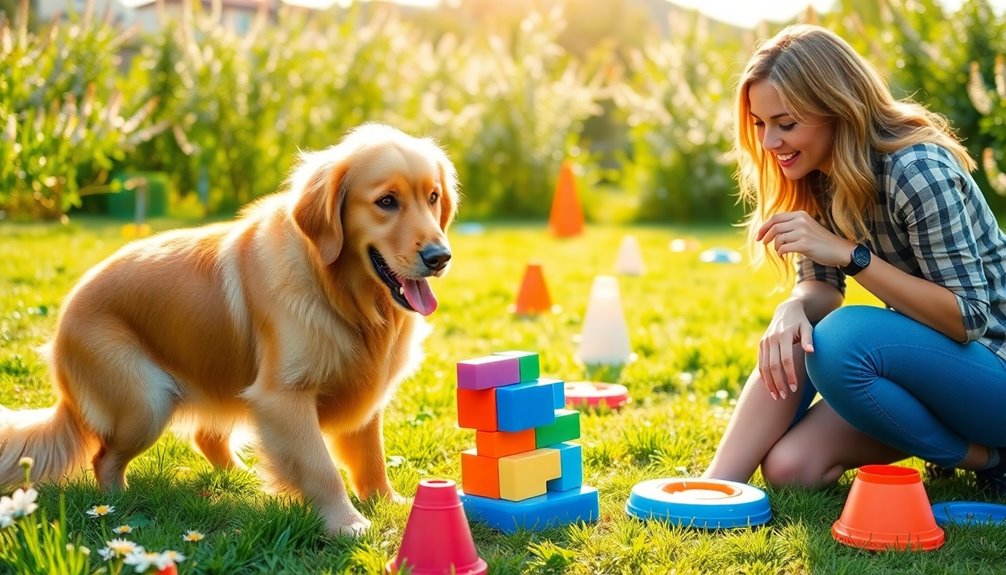
When you engage your dog's mind with mental stimulation techniques, you're not just keeping them entertained; you're also enhancing their overall well-being.
Using puzzle toys is a fantastic way to promote problem-solving skills while providing interactive play. These toys challenge your dog to think critically and figure out how to access treats or toys hidden inside, making playtime both fun and educational.
Incorporating interactive brain games into your daily routine can greatly reduce boredom and anxiety. Activities like teaching your dog the names of their toys through repetition boost cognitive engagement and make communication between you and your pet stronger.
You can also use talking buttons that allow your dog to combine words into phrases, fostering more complex communication and further enhancing mental stimulation.
Regular training sessions are essential, too. They not only improve cognitive function but also offer new challenges that keep your dog engaged and excited to learn. Engaging in problem-solving activities can further enhance your dog's cognitive skills and overall development.
With these techniques, you'll not only entertain your furry friend but also contribute to their mental health and happiness. So, get creative and watch your dog thrive!
Importance of Physical Exercise
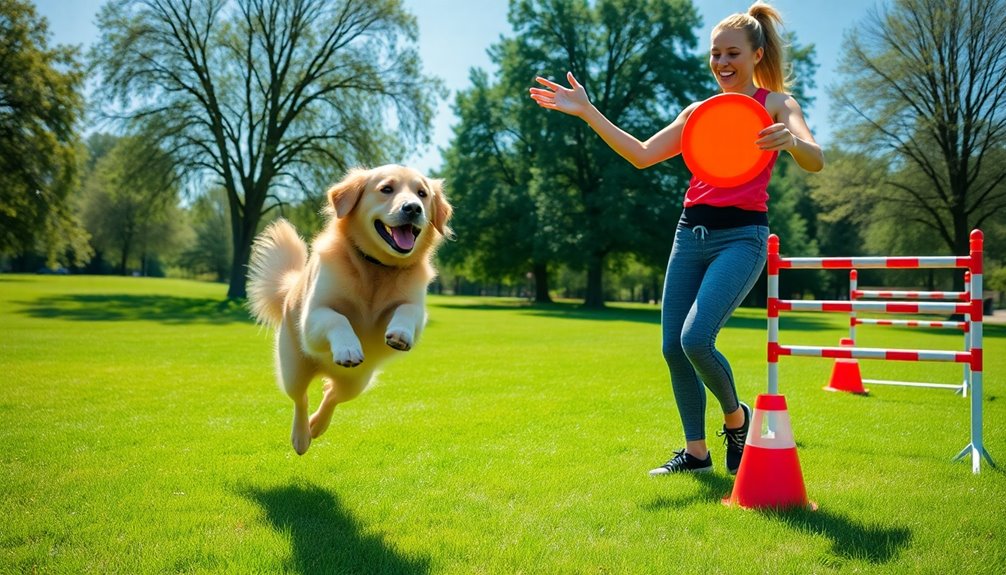
Physical exercise is essential for your dog's overall health and happiness. Engaging in daily walks provides not just physical exercise but also essential mental stimulation, enhancing your dog's well-being. A simple walk can turn into an adventure that keeps your furry friend alert and engaged.
Incorporating fetch games into your routine is another great way to improve your dog's stamina and speed while deepening your bond. If you have a senior dog or one with joint issues, consider swimming as a low-impact exercise option that promotes fitness without causing strain.
Agility courses can also be a fantastic addition to your dog training regimen, greatly improving coordination and physical capabilities while keeping things fun.
Remember, regular physical activity tailored to your dog's age and energy level is essential for weight management, which supports longevity and overall health.
Make sure to mix up activities to keep your dog excited and motivated. With consistent physical exercise, you'll not only see a happier, healthier dog but also strengthen your relationship through shared experiences.
Prioritizing exercise is the key to a fulfilled and active life for your furry companion.
Engaging Walks and Exploration

Taking your dog for a walk can be more than just a routine exercise; it can become an exciting adventure filled with exploration. By changing your walking routes, you introduce new sights and scents that engage your dog and enhance their mental stimulation.
Allowing your pup to stop and smell the world around them encourages their natural foraging behavior, which is essential for their mental well-being.
Here are some tips to make your walks more engaging:
- Change your route: Explore different paths to keep things fresh.
- Scatter treats: Hide treats in the grass to promote foraging behavior.
- Mindful walking: Focus on the journey, not just the destination, to strengthen your bond.
- Switch sides of the street: Altering your starting point keeps your dog curious.
These strategies not only help engage your dog but also make every outing a fun exploration.
Positive Reinforcement Strategies
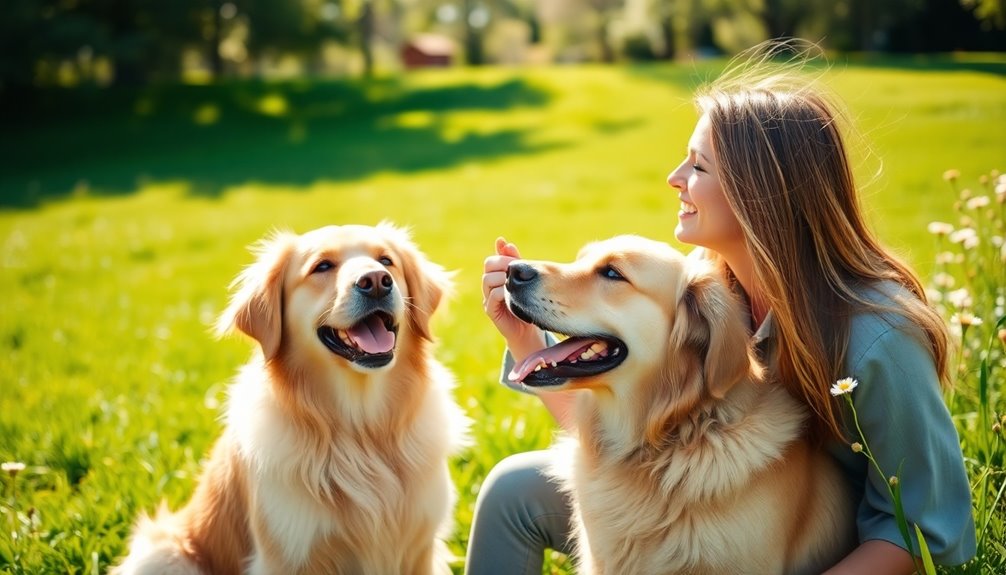
Positive reinforcement strategies are essential for effective dog training. By rewarding your dog with treats, praise, or play when they exhibit desired behaviors, you increase the chances of those behaviors being repeated in the future.
One powerful method is clicker training, which allows you to mark desired actions immediately. This instant feedback helps your dog understand and retain commands more effectively.
When using positive reinforcement, consistently pair verbal commands with rewards. This creates a clear association, making it easier for your dog to learn and respond. If your pup is food motivated, incorporate high-value treats during training sessions, especially for challenging commands. This boosts their motivation and focus, ensuring they're engaged and enthusiastic to learn.
Moreover, building a strong bond of trust with your dog through positive reinforcement fosters a relaxed learning environment. When your dog feels safe and supported, they're more likely to enjoy the process and learn quickly.
Socialization for Well-Being
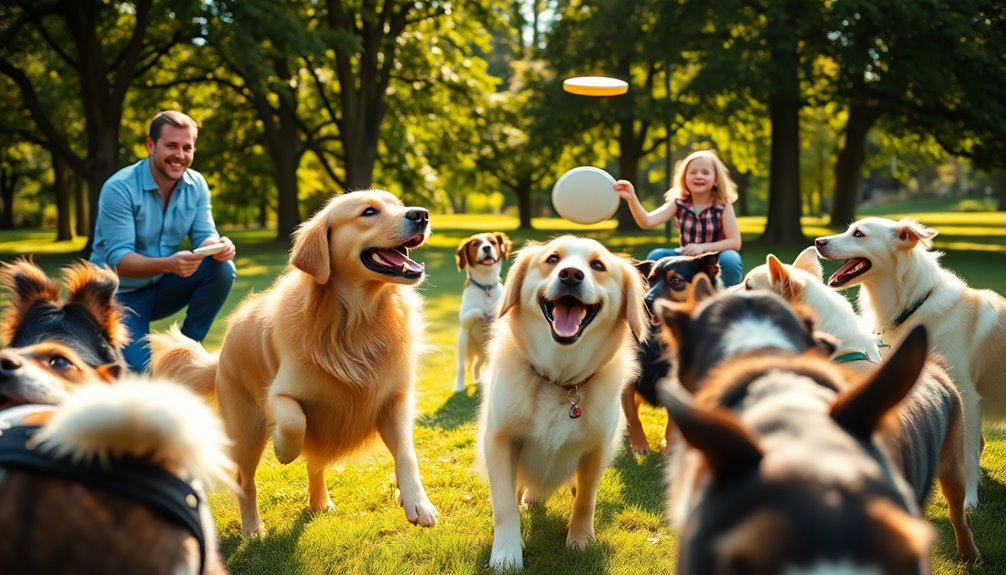
Socialization is essential for your dog's overall well-being, as it exposes them to various environments, sounds, and experiences. This vital process helps build confidence and reduces fearfulness in unfamiliar situations.
As a dog owner, you'll want to prioritize socialization alongside obedience training to guarantee a well-rounded pup. Engaging in regular interactions with other dogs can enhance your dog's social skills and prevent behavioral issues, such as aggression and anxiety.
Consider structured socialization activities, like dog parks or training sessions, to provide your furry friend with the chance to learn appropriate play and communication skills.
Here are some key benefits of socialization:
- Builds confidence and reduces fearfulness.
- Prevents behavioral problems, like aggression and anxiety.
- Improves obedience through shared experiences in group settings.
- Influences your dog's temperament positively throughout their life.
Effective Communication Development
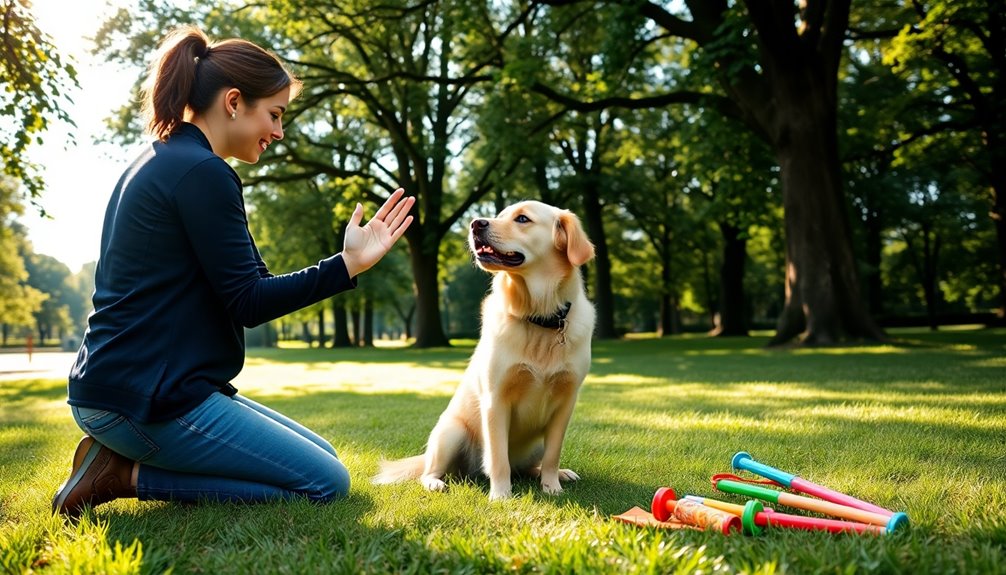
Effective communication is key to training your dog successfully.
By using consistent verbal commands paired with visual cues, you can help your furry friend make strong word associations and better understand what you expect.
Word Association Techniques
Understanding the nuances of word association can greatly enhance your dog's communication skills. By consistently pairing dog commands with reliable outcomes, like associating "walk" with going outside, you can boost your dog's vocabulary. Using enthusiastic, higher-pitched tones helps engage your pup, making them more open to learning new words and commands.
Here are some effective word association techniques to contemplate:
- Always use the same command for the same action to reinforce learning.
- Incorporate happy tones and baby talk to create a positive learning environment.
- Pair verbal commands with distinct gestures to leverage your dog's visual learning abilities.
- Use interactive tools, like talking buttons, to encourage your dog to express their needs.
Consistency is key in both your vocal communication and visual signals. This clarity leads to a better understanding, making training your dog much more effective.
Visual Cues Importance
Incorporating visual cues into your dog training can really boost communication and learning. Since dogs are primarily visual learners, using distinct gestures alongside your verbal commands is essential for effective training. When you consistently pair visual cues with commands, you enhance your dog's understanding and retention of learned behaviors.
Try using clear and simple hand signals to improve your dog's responsiveness. This way, they can easily connect the visual cue with the desired action. Your body language also plays a significant role; positive engagement, like using excited movements, encourages your dog to pay attention and actively participate in training sessions.
Moreover, visual cues can help dogs navigate distractions more effectively. When they see your signals, it reinforces their focus and compliance, making it easier for them to respond amid distractions.
Consistent Communication Patterns
Consistency in communication is key to successful dog training. When you establish clear, reliable patterns, your dog should understand what you expect. Pairing verbal commands with distinct gestures can greatly enhance their learning, as dogs are primarily visual learners. This approach makes it easier for them to connect the command with the desired response.
Here are some tips to maintain consistent communication:
- Use the same phrases for commands to prevent confusion.
- Employ happy, higher-pitched tones to encourage engagement.
- Deliver immediate rewards within 2 seconds of the desired behavior to reinforce learning.
- Teach names for toys or actions to strengthen your bond and improve cognitive skills.
Fun Training Activities
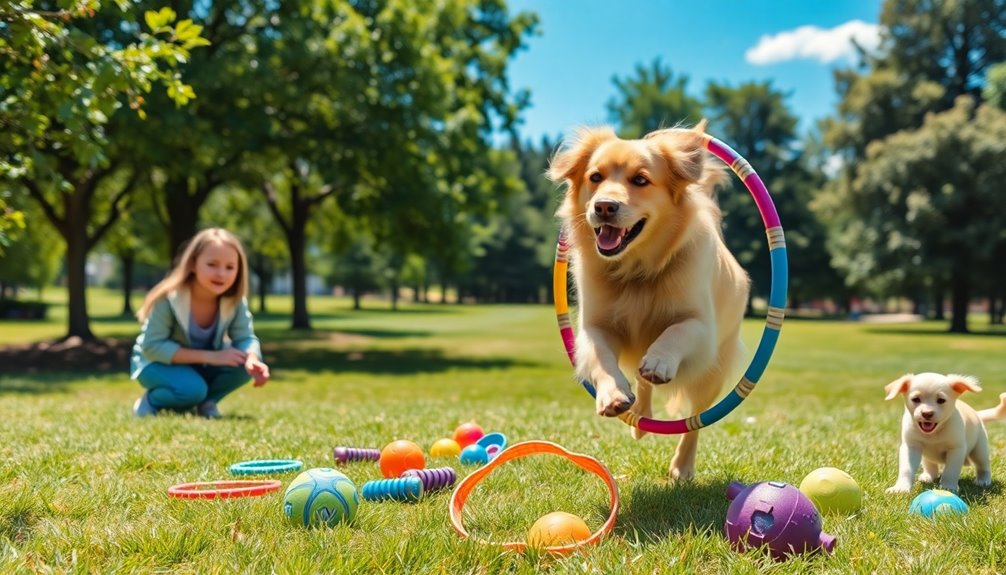
Trick training and interactive games can make training sessions a blast for both you and your dog.
Not only do these activities strengthen your bond, but they also keep your pup mentally stimulated and engaged.
Let's explore some fun tricks and games that can add excitement to your training routine!
Trick Training Ideas
Engaging in trick training not only makes learning enjoyable for your dog but also deepens the bond you share. This process enhances communication and trust, creating a stronger relationship.
Start with tricks that align with your dog's natural strengths; this encourages motivation and success.
Incorporate fun tricks like:
- Playing dead
- Rolling over
- Shaking paws
- Jumping through hoops
These activities boost your dog's confidence and skill development through positive reinforcement. Using clicker training can further improve communication by helping your dog associate the click sound with desired behaviors, enhancing retention.
Don't forget to integrate enrichment activities, such as scent work or obstacle courses, into your trick training sessions. These not only provide mental stimulation but also physical activity, ensuring your dog remains engaged and happy during training.
Interactive Games for Dogs
Incorporating interactive games into your dog's training routine can elevate the fun and strengthen your bond even further. These games provide essential mental stimulation and are perfect for enhancing your pup's cognitive functions.
Try playing hide-and-seek, which taps into your dog's natural instincts while honing their problem-solving skills. They'll love using their keen sense of smell to track you down!
Puzzle toys are another fantastic option; they challenge your dog to figure out how to retrieve treats, keeping them engaged and reducing boredom or anxiety.
Teaching your dog the names of their toys creates a fun game where they learn to fetch specific items, reinforcing vocabulary growth through repetition. You can also introduce talking buttons, allowing your dog to communicate their needs and desires, which deepens your interaction.
Lastly, scent work games, like foraging for hidden treats, not only provide mental stimulation but also give your dog a great physical workout.
Age-Appropriate Training Methods
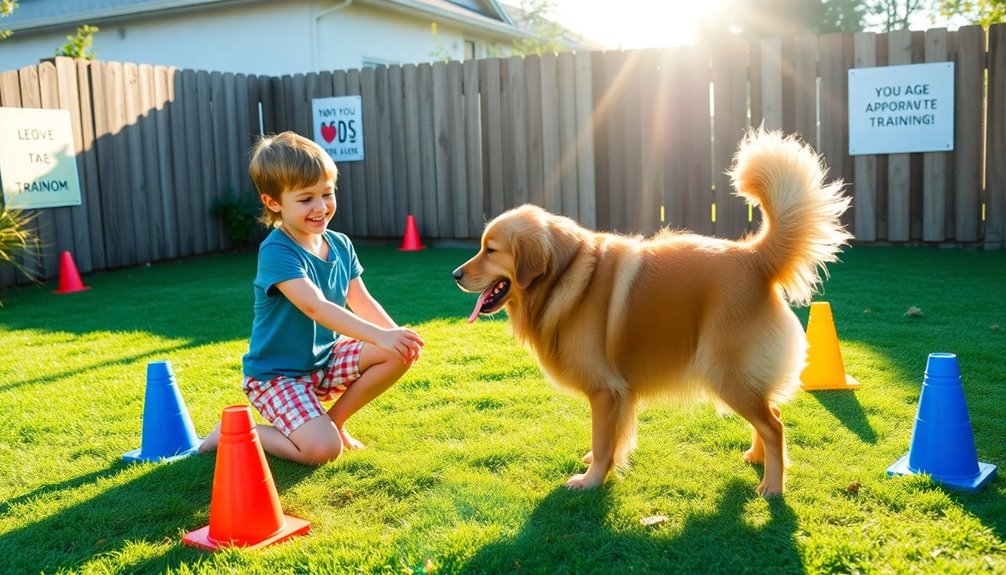
When it comes to dog training, age matters considerably, as different life stages require tailored approaches. Puppies and senior dogs have unique needs, so employing age-appropriate training methods is essential for their development and well-being.
For puppies, focus on safe and gentle activities that promote healthy growth. Consider incorporating:
- Short play sessions to enhance physical health
- Basic socialization with other dogs for behavioral development
- Positive reinforcement techniques to encourage desired behaviors
- Consistent routine to establish security and trust
On the other hand, senior dogs thrive on low-impact activities. Aim for leisurely walks and engage them in mental stimulation to keep their cognitive function sharp.
Utilize puzzle toys and scent work to prevent boredom and anxiety.
Nutrition for Optimal Performance
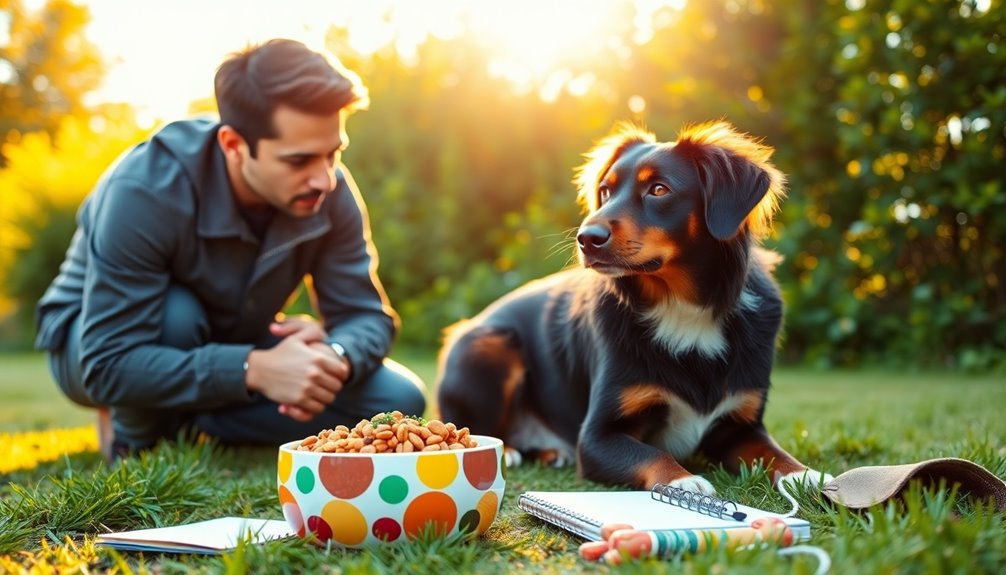
Nutrition plays an essential role in your dog's training success and overall well-being. A nutrient-rich diet supports brain health and cognitive function, critical for enhancing your dog's memory and learning capabilities. Incorporating omega-3 fatty acids into their meals can greatly boost these functions, making it easier for them to grasp commands and perform tasks.
To guarantee peak performance, consider adding fresh fruits and vegetables to your dog's diet. These foods provide essential vitamins and antioxidants that contribute to both physical and mental health. However, portion control is important to prevent obesity-related health issues that can hinder your dog's energy levels during training.
Establishing a consistent feeding schedule can also make a difference. It aids digestion and helps regulate energy levels, making certain your dog remains alert and focused during training sessions.
Regularly assess your dog's dietary needs based on their activity level and age, adjusting their food intake as necessary to meet their specific training goals. By prioritizing nutrition for peak performance, you're setting your dog up for success, both in training and in their overall health.
Establishing Routine and Structure
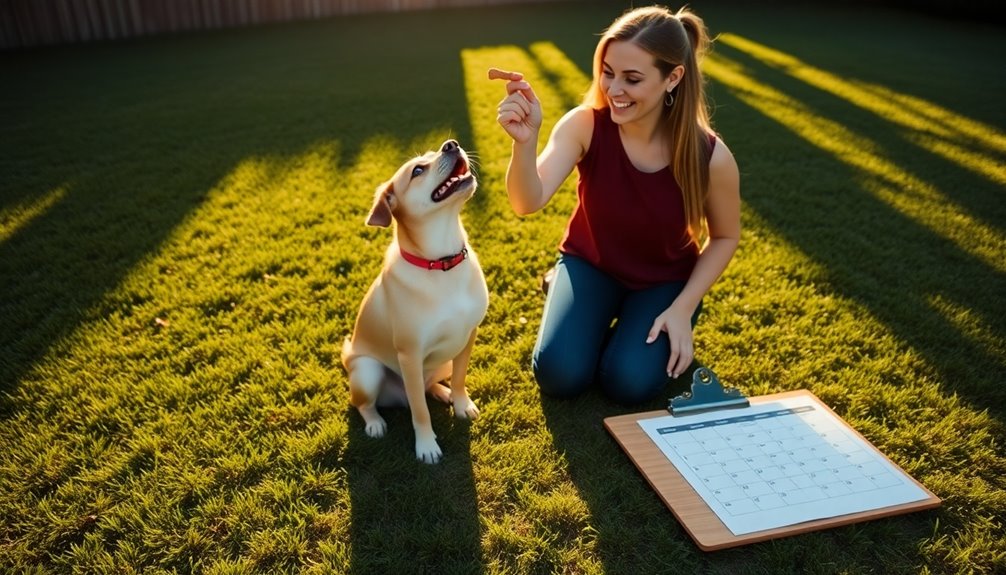
Creating a routine for your dog not only enhances their sense of security but also lays the groundwork for effective training. A consistent schedule helps reduce anxiety and makes your dog feel stable in their environment.
By establishing daily rituals, you're promoting predictability that leads to improved behavior and a better understanding of expectations.
Consider incorporating the following elements into your dog's daily routine:
- Set Feeding Times: Consistent meal times foster security and can improve your dog's behavior around food.
- Regular Walks: Schedule daily walks to provide exercise and mental stimulation, reinforcing structure in their day.
- Structured Playtime: Dedicate time for play that strengthens your bond and encourages healthy habits.
- Consistent Sleep Patterns: Guarantee your dog has a quiet place to rest, promoting better mood and cognitive function.
Training routines that are consistent and repetitive help build discipline and focus.
Frequently Asked Questions
How to Train Your Dog Like a Professional?
To train your dog like a professional, start with positive reinforcement techniques. Use clicker training to mark desired behaviors, followed by rewards to encourage engagement.
Incorporate choice training, allowing your dog to make decisions during sessions. Pair verbal commands with clear gestures, as dogs respond better to visual cues.
Keep training sessions short and frequent, ideally 2-3 times a day, and adapt your methods based on your dog's unique temperament for better results.
What Is the 5 Second Rule in Dog Training?
Did you know that dogs can learn commands in as little as five repetitions?
The 5 Second Rule in dog training means you should reward your dog within five seconds of them displaying the desired behavior. This timing helps create a clear connection between their action and the reward, making it easier for them to understand what you want.
Staying attentive and consistent reinforces learning and strengthens your bond with your furry friend.
What Is the 1/2/3 Dog Training Method?
The 1/2/3 Dog Training Method is a structured approach that helps you train your dog effectively.
First, you give a command, then wait a moment for your dog to respond. If there's no response, you gently guide them into the desired behavior.
This method emphasizes consistency and clarity, making it easier for your dog to understand what you expect.
Plus, rewarding successful responses with praise strengthens your bond and encourages positive behavior.
What Is the 3 Second Rule in Dog Training?
They say, "A stitch in time saves nine," and that's especially true in dog training.
The 3 Second Rule means you should reward your dog within three seconds of them performing a desired behavior. This quick reinforcement helps them connect the action with the reward, making learning clearer.
If you wait too long, your dog might get confused about what they did right. Consistently applying this rule keeps your training sessions effective and enjoyable!
Conclusion
By blending mental stimulation and physical exercise, you're not just training your dog; you're building a bond that deepens with every shared adventure. As you explore new trails or teach a fun trick, you'll discover that your dog's growth mirrors your own. The laughter during training sessions and the quiet moments of companionship reveal a beautiful coincidence: the more you invest in their well-being, the more joy and fulfillment you both experience in life's journey together.

